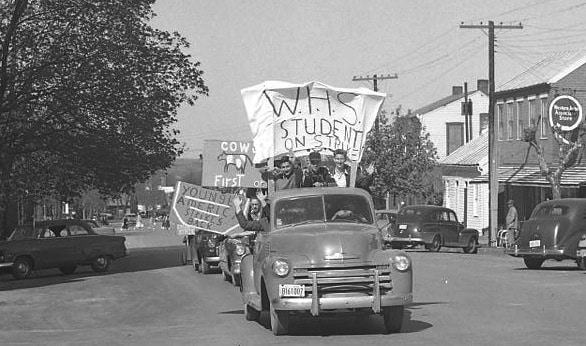Remembering the ‘cow time’ protest 60 years later

Students parade through town with signs on vehicles protesting the school board’s decision not to recognize daylight savings time in 1953. (Bob Voris photo)
The sight of picket signs and crowds of marching protestors evoke images of our country’s struggles during the turbulent 1960s. Many remember news reports and film of rioters jamming sidewalks and streets, protesting various issues during that era.
But a few years before then, the small town of Waterloo became embroiled in a controversy of its own; and it all began with milking cows.
While most everyone can make the change from standard to daylight savings time with little more than a few bleary-eyed mornings of losing an hour of sleep, farm animals do not know the difference. Therefore, animals would need to be fed at the same time, regardless of clocks being changed over.
Cows need to be milked at the same time, too.
At the urging of rural farm families in the early spring of 1953, the Waterloo School Board began discussing the issue at their meetings shortly after the holiday season and voted to leave school hours on standard time while everyone else would “spring forward” to daylight savings time on April 26.
More than half of Waterloo students were from farm families in 1953, and parents were worried their children would be forced to leave the farm too early under the daylight savings time rules.
Regardless of the large number of farm families supporting the board’s decision, there were also a large number of citizens who opposed the move. Opponents argued the rest of the town was switching over and so should the schools.
As is common in most small towns, many citizens made the argument personal, citing that the board president himself was the owner of a sizeable dairy farm and he was worried about getting the cows milked on time.
A special board meeting was held in the WHS assembly room on April 22, 1953, and was well attended; 25 representatives from several farm families were there to support the board decision. There was also a large contingent of students there who were not in favor of the motion. Many of them had parents to back them up with petitions hoping to change the board’s ruling.
During the discussion, rural citizens pointed out at that their children must rise at 6:30 a.m. to get on the school bus. Under daylight savings time, this time would be moved to 5:30 a.m.
Opponents pointed out that many area farmers change to daylight savings time during the summer months. Farmers in attendance stated they had to work with the sun.
At the urging of two new board members, a motion was made to overturn the ruling made earlier and change the schools over to daylight savings time. By secret ballot, the motion did not pass. Three members were for the motion, but four were against. School hours would remain on standard time.
Students milled around following the meeting, many incensed at the decision. Most wanted to do something to show their opposition.
“It became a standoff of sorts,” recalls Bob Walhaus, who was a junior at WHS in 1953. “Both sides were saying, ‘Well, why should we be forced to change?’”
Students soon came to the consensus they would stage a strike and not attend classes. Word spread quickly, and the strike was not reserved for high schoolers — junior high and even grade school students got involved, as well.
“I remember we met in someone’s basement and began painting signs and preparing for the strike,” recalls Jean Kohler Schutt, a WHS student at the time.
On Monday morning, April 27, students began congregating outside the school. Books were placed under a tree. A drum and bugle corps assembled, lead by two majorettes. Cars, motorcycles, scooters, and bicycles were decorated. Protest signs read “To Milk or Not to Milk on Standard Time? That is the Question” and “Students NOT Cows Come First.” Perhaps one of the more controversial signs read “Milkers Wanted” and advertised the phone number of the school board president. Students soon labeled the start of school as “Cow Time.”
According to newspaper reports from the first day of the strike, the students were enthusiastic. Papers reported that all but about a dozen of the high school students were on strike, joined by more than 80 students from grades 2-8. The Waterloo Republican reported that “the students had a fine time parading up and down Main Street with drums and bugle music.” Newspaper photos showed empty classrooms and the school campus crowded with protestors.
Area ice cream parlors reported an increase in business the week of the strike, with protestors pausing from time to time for refreshments.
Tuesday morning began with a smaller crowd of students organizing a parade, yet it seemed the effort lacked enthusiasm from the previous day.
Schutt said the strike continued for the rest of the week with students “cutting class and running around town.”
Walhaus recalls neither the school board nor students seemed willing to “budge” when it came to changing their minds. Indeed, students continued to remain out of school on Wednesday and Thursday. Rumors of strikes in neighboring communities began to surface, including the planned strike of Sparta students when the school board there made a similar ruling.
Although there were no parades or large lines of picketers the remainder of the week, students still made their views known in other ways from Wednesday to Friday.
“One of the things we did, that I am not particularly proud of, was driving out to the farm of the school board president, Marcellus Hartman,” recalls Bob Walhaus. “We all got in a long line of cars and drove around that farm honking our horns and causing a big scene.”
Walhaus happened to be best friends with the son of Mr. Hartman, and he regretted his participation in the strike at times.
“Kenneth was forced to go to school and I’m sure he would have rather gone with us because the strike was a lot of fun. I ended up apologizing to him after the strike was over,” he said.
With neither side willing to budge, school board members again called a special meeting and held a closed session with only board members in attendance.
“The other school board members finally convinced Mr. Hartman that it was in the best interest of the students to change school house to daylight savings time. It was an exciting time for us because it was a small town and we weren’t used to such controversy,” Walhaus said.
Word soon spread that the board was changing its mind. Students celebrated with victory drives through towns and again treated themselves at local teen hangouts.
As the weekend ended and Monday morning was upon them, it was soon clear that students would be forced to return to their normal routines, regardless of their victorious win.
“Our parents supported us. But in the end, they all said ‘Alright. It’s time to get back to work now,’” Walhaus said.






